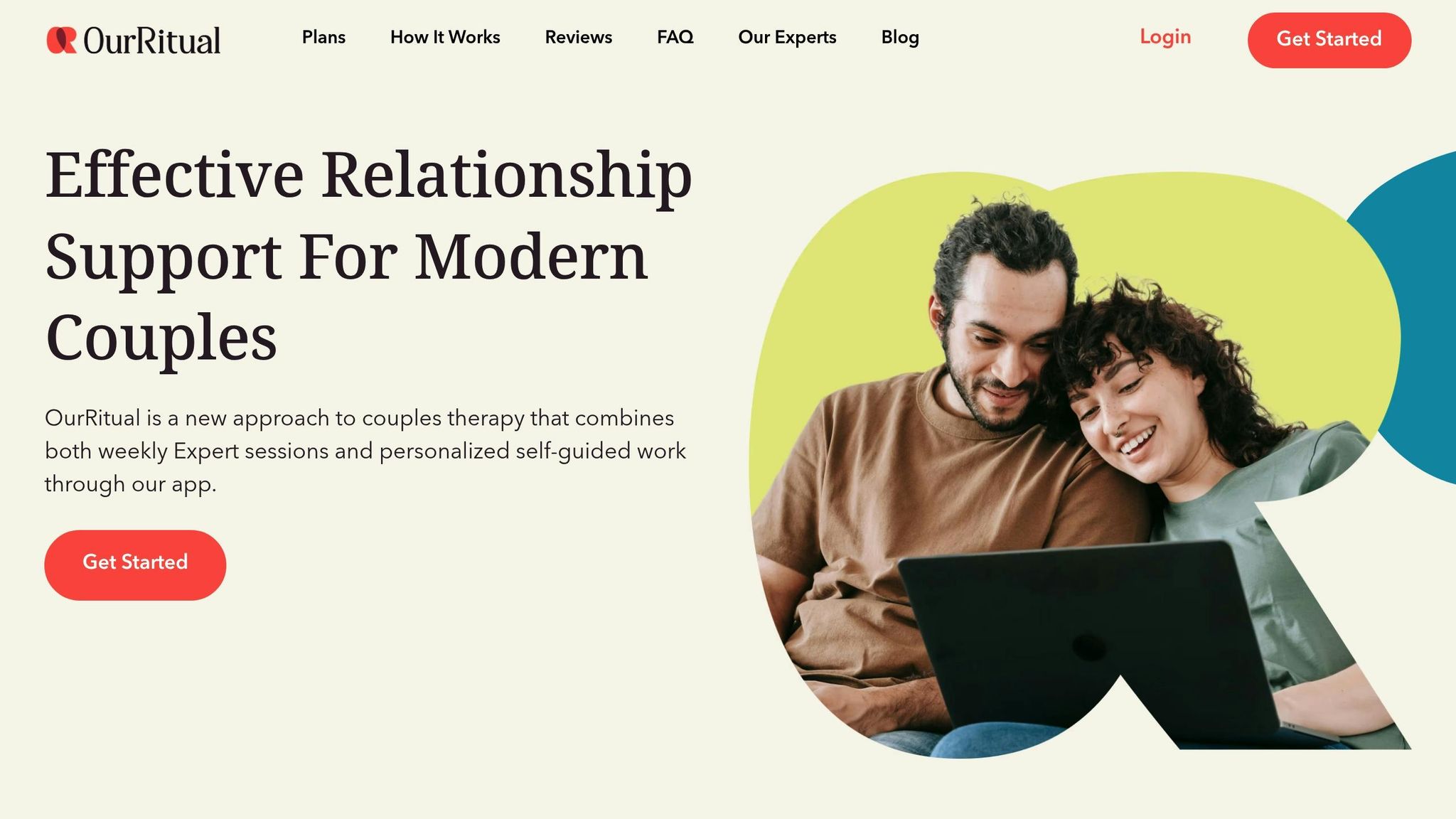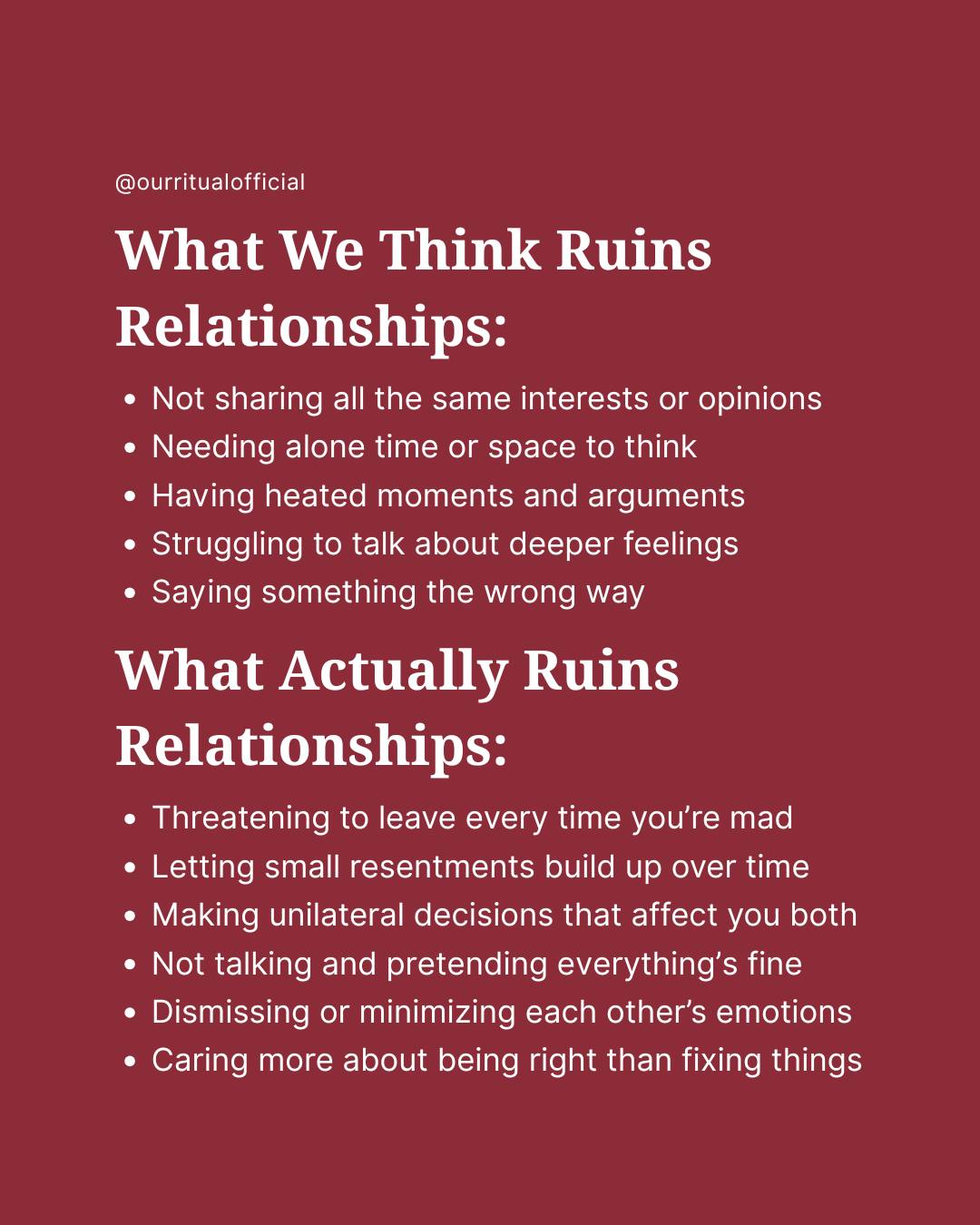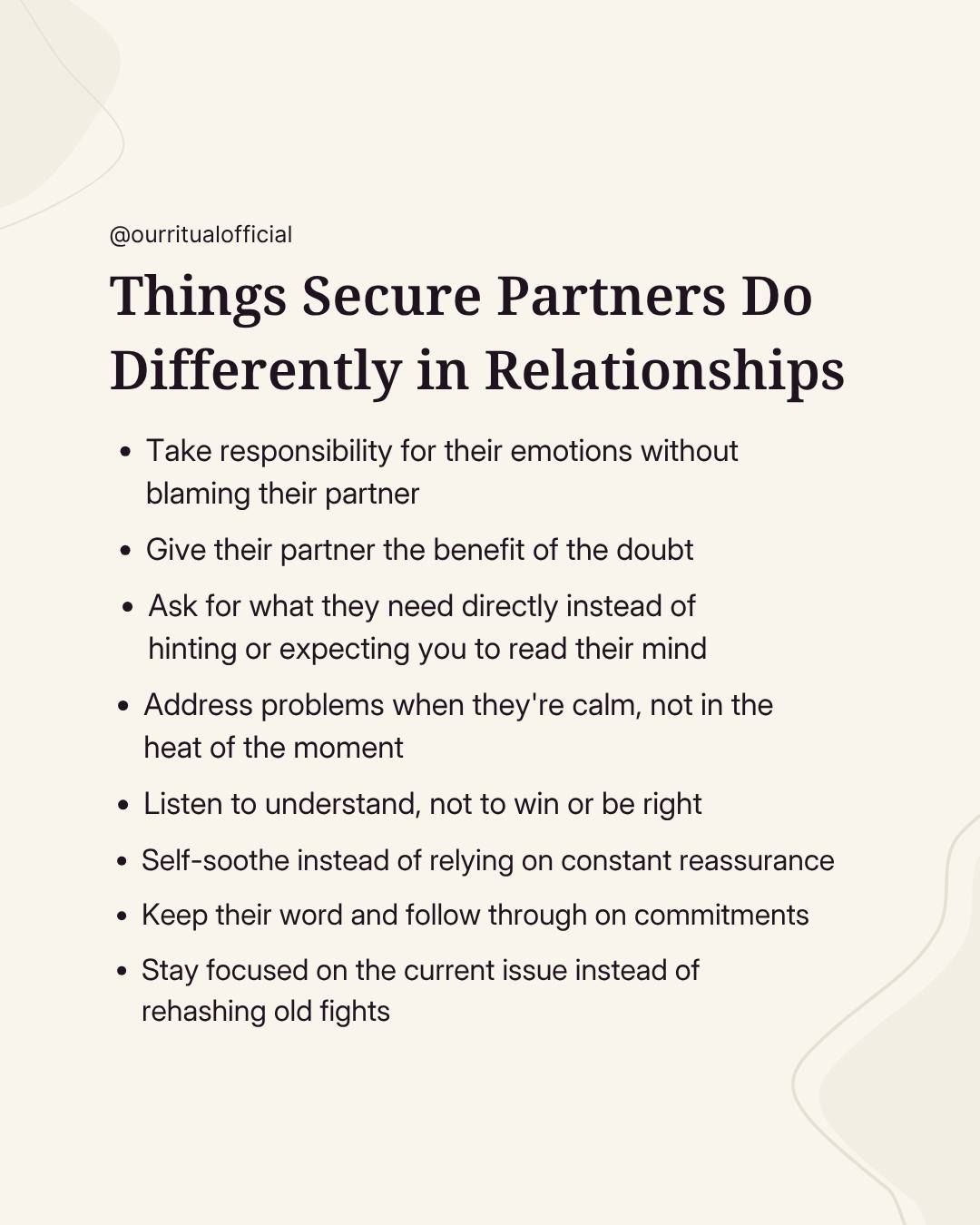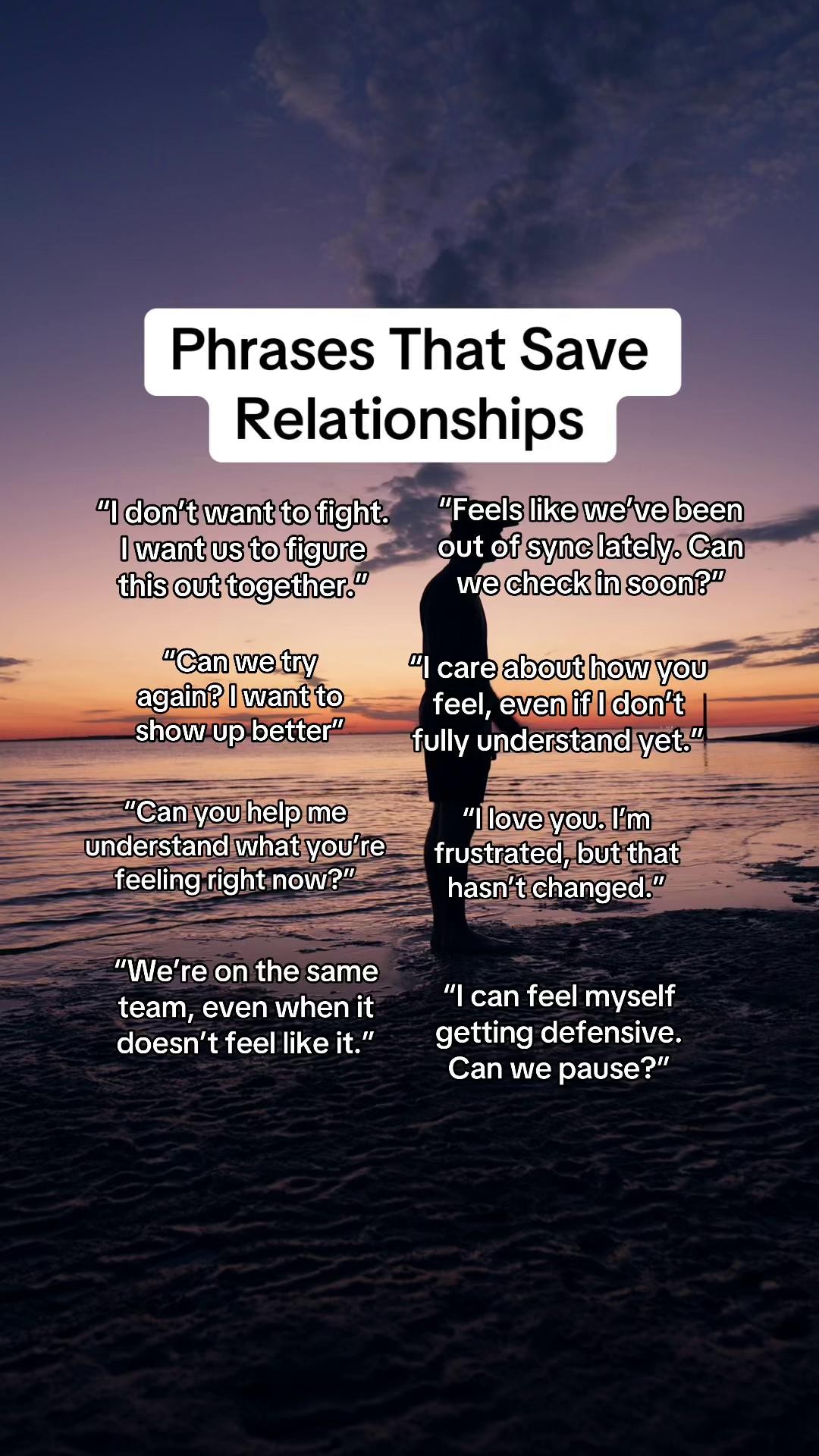Communication Problems: 5 Solutions That Work
When communication breaks down in relationships, it can lead to emotional distance, recurring arguments, and unresolved conflicts. But the good news is that improving communication is possible with the right strategies. Here are five practical solutions you can start using today:
- Active Listening: Focus on truly understanding your partner's words and emotions by giving your full attention, paraphrasing, and asking clarifying questions.
- 'I-Statements': Express your feelings without blaming by framing sentences like, "I feel [emotion] when [situation] because [impact]."
- Structured Dialogue: Use timed sharing or mirroring exercises to create a safe, respectful space for open conversations.
- Conflict Resolution: Calm down before addressing disagreements, then work together on solutions that benefit both partners.
- Digital Tools: Platforms like OurRitual offer expert-led sessions and tailored exercises to strengthen communication skills.
These strategies help you connect better, avoid misunderstandings, and handle conflicts constructively. Whether you start with one method or combine several, the key is consistent effort to build a stronger, more understanding relationship.
Solution 1: Active Listening Techniques
Active listening is a game-changer when it comes to strengthening connection in relationships. It’s not just about hearing words - it’s about connecting with the message and the emotion behind them. By doing so, you can minimize misunderstandings and strengthen the connection with your partner.
What Active Listening Is and Why It Matters
Active listening means giving your undivided attention, focusing entirely on your partner’s thoughts and feelings instead of planning your next response. It’s about being present in the moment.
Tone, body language, and emotional cues often carry more weight than the words themselves. Active listening ensures you pick up on these subtle, yet crucial, signals.
If you’re ready to sharpen your active listening skills, here’s how to get started.
How to Practice Active Listening: Step-by-Step
Mastering active listening takes practice, but it’s worth the effort. Here are some techniques to guide you:
- Give your full attention: Eliminate distractions, maintain eye contact, and focus on both the words and emotions being expressed.
- Paraphrase: Reflect back what you’ve heard, like saying, “So you’re feeling overwhelmed and unsupported?”
- Ask clarifying questions: If something isn’t clear, ask for more details, such as, “Can you explain how that made you feel?” This shows genuine interest and encourages deeper conversation.
- Acknowledge emotions: Pay attention to tone and body language. If your partner shares something difficult, respond with empathy, like, “That sounds really challenging. I can see why you’d feel frustrated.”
- Stay calm and open-minded: Avoid interrupting or getting defensive. Focus on understanding their perspective rather than jumping in to defend your own.
Solution 2: 'I-Statements' for Better Expression
Conversations can quickly spiral when one person feels attacked and the other feels ignored. That’s where 'I-statements' come in - they’re a way to express how you feel without putting your partner on the defensive. Instead of escalating tension, they can turn heated moments into chances to connect.
How 'I-Statements' Work
'I-statements' focus on your emotions and experiences rather than pointing fingers. They follow this structure: "I feel [emotion] when [situation] because [impact]."
The magic lies in ownership. Unlike 'you-statements,' which often sound accusatory, 'I-statements' take responsibility for your feelings.
Here’s how ‘I-statements’ stack up compared to ‘you-statements’ in tone and impact:
You-Statement Traits vs. I-Statement Traits
- You-Statement: Blames and generalizes
I-Statement: Describes specifics - You-Statement: Assigns fault
I-Statement: Takes ownership - You-Statement: Highlights problems
I-Statement: Suggests solutions - You-Statement: Sparks defensiveness
I-Statement: Promotes openness - You-Statement: Claims opinions as facts
I-Statement: Allows for different views
Tone is just as important as the words themselves. Delivering 'I-statements' calmly ensures your partner hears the message instead of preparing to defend themselves.
Examples of 'I-Statements' in Action
Here’s how 'I-statements' can reshape common conflicts:
- Household responsibilities:
- You-statement: "You didn’t clean up like you said you would! You make me so upset!"
- I-statement: "I feel frustrated that the trash hasn’t been taken out yet. I’d appreciate it if you could handle that."
- Needing emotional support:
- You-statement: "You think I haven’t already tried all of that?! You just don’t understand."
- I-statement: "I appreciate you wanting to help, but I don’t need advice right now. I’m feeling stressed and sad. Could you just hold me and listen?"
- Forgetfulness:
- You-statement: "You’re so forgetful! Are you even paying attention?"
- I-statement: "I feel hurt and overlooked when something we’ve discussed doesn’t seem to stick."
- One-sided communication:
- You-statement: "You never tell me how you’re feeling."
- I-statement: "I’d really like to know how you’re feeling about this."
Notice how 'I-statements' focus on behaviors and emotional impact rather than attacking someone’s character. This approach fosters understanding and keeps the conversation constructive.
Solution 3: Structured Dialogue Exercises
Once you've got the hang of active listening and using 'I-statements,' structured dialogue exercises can take your communication skills to the next level. These exercises go beyond good intentions, offering a clear framework where couples can share openly without interruptions or judgment.
What Structured Dialogue Exercises Are
Structured dialogue exercises follow a set format to keep communication productive and respectful. Unlike casual conversations that can sometimes veer off course or escalate into arguments, these exercises establish firm boundaries to help couples practice effective communication techniques.
The process typically involves three stages: a warm-up to prepare emotionally, a focused practice session to work on specific communication skills, and a positive wrap-up that reinforces progress.
Research from The Gottman Institute highlights the impact of healthy communication. It shows that couples who communicate well are less likely to divorce, build stronger trust, and even enjoy better physical health. [8]
These exercises are effective because they combine active listening and conflict resolution within a structured environment. With this framework in mind, you can start practicing at home.
How to Do Structured Dialogue at Home
You don’t need fancy tools or professional training to try structured dialogue exercises. Here’s how to get started:
Timed Sharing is a simple yet powerful technique. Set a timer for 3-5 minutes, allowing one partner to speak uninterrupted while the other listens attentively. The listening partner can acknowledge what’s being said with phrases like "I hear you" and maintain eye contact. When the time is up, switch roles.
During the listening phase, the focus is entirely on understanding, not responding. Non-verbal cues like nodding or an open posture can also show engagement.
Mirroring is another helpful tool. One partner shares their thoughts, and the other repeats back what they heard, starting with, "I heard you say...". This helps uncover misunderstandings and ensures clarity.
Validation adds an extra layer of connection. Use phrases like "I understand why you feel that way" or "I’m sorry you went through that" to show empathy. Remember, validation doesn’t mean agreeing with everything - it’s about acknowledging your partner’s experience.
Here’s how this works in real life. A couple adjusting to life with a new baby might use guided conversations to discuss sleep routines. The warm-up phase ensures both are mentally prepared, the main session allows them to share their feelings and ideas, and the cool-down reinforces their teamwork.
Similarly, a couple struggling with financial disagreements could use this approach to shift how they talk about money. They might start by reviewing last month’s spending (warm-up), listen to each other’s perspectives on finances (main discussion), and then collaborate on a budget that works for both (positive wrap-up).
Making Sure Both Partners Get Equal Time
For structured dialogue to work, both partners need equal opportunities to speak. Uneven participation can deepen communication gaps instead of bridging them.
The "40-20-40" exercise is a great way to ensure balance during conversations: each partner gets 40% of the time to speak, and the remaining 20% is reserved for joint discussion. This means one partner shares their perspective for 40% of the time, then the other partner gets their own 40%, followed by a shared space for reflection and collaboration.
To maintain fairness, both partners should gently remind each other to avoid interruptions and keep their comments concise. Setting ground rules can also help - make sure basic needs are met before starting, focus on one topic at a time, and end with positive affirmations.
Consistency beats perfection. Use signals or "code words" to pause the conversation if tensions rise. The goal isn’t flawless communication from the start but building better habits over time. By practicing regularly, you’ll create a foundation for healthier, more productive conversations.
Solution 4: Conflict Resolution Methods That Work
Building on the foundations of active listening and structured dialogue, effectively managing conflict is key to improving relationships over time. Disagreements are a natural part of any partnership, but they can also be opportunities to strengthen your bond by turning heated moments into chances for growth.
How to Calm Down During Arguments
When emotions run high, clear thinking and effective communication often take a back seat.
If you feel overwhelmed during an argument, let your partner know you need a break to cool off. This pause creates space for a more productive conversation later. Simple techniques like slow, deep breathing can help relax both your body and mind. Focusing on physical sensations - rather than spiraling thoughts - can also be grounding.
When anger flares up, take immediate action to calm yourself. This might mean stepping away for a short walk, listening to calming music, or finding a moment to laugh and release tension. Offering yourself kindness during these moments can also make a big difference. On the flip side, avoid sharp comebacks or raising your voice, as these can escalate the conflict further.
Once you've regained your composure, you can approach the disagreement with a clearer mindset. Here's a structured method to turn conflicts into meaningful conversations.
A Simple Process for Solving Disagreements
After emotions have settled, a structured approach can help transform conflict into a productive discussion. Here’s a four-step process for resolving disagreements in a way that works for both partners:
- Calm lingering emotions to enable open listening.
Both partners should feel emotionally ready to engage in a constructive conversation. - Commit to a Win-Win Posture.
Focus on finding solutions that benefit both individuals equally. - Adopt Purposeful Listening.
Listen with the intent to truly understand your partner's perspective and needs, avoiding judgment. - Practice Collaborative Problem-Solving.
Share ideas and concerns openly to discover solutions that work for both of you.
Throughout this process, address one concern at a time, remain open to your partner's perspective, and assume good intentions.
Once you've worked through these steps, digital tools can offer additional support for maintaining progress and improving communication.
Solution 5: Digital Relationship Support Tools
Once you've nailed down traditional communication techniques, digital solutions offer a modern way to further strengthen your relationship. These platforms are designed to be accessible and affordable, giving couples immediate access to expert guidance, tailored exercises, and structured programs they can work through at their own pace.
How OurRitual Supports Communication Skills

Building on the communication strategies mentioned earlier, OurRitual is designed to address the unique challenges of today’s relationships. The platform offers weekly expert-led sessions and digital exercises aimed at improving communication.
Here’s how it works: Couples can participate in 20- to 40-minute virtual sessions with licensed professionals, available around the clock. These sessions are paired with self-guided exercises on the app, which include curated resources, progress tracking, and actionable steps. Unlike traditional therapy, OurRitual focuses on teaching relationship skills and providing education rather than clinical intervention.
OurRitual was designed with flexibility in mind, making it easier for couples to work at their own pace and focus on what matters most to them. Sessions can be attended together or separately, and the platform uses Pathways - guided learning tracks focused on specific goals and challenges - to help couples build skills step-by-step.
Digital Tools vs. Traditional In-Person Support
Digital tools like OurRitual offer several advantages over traditional in-person counseling, especially when it comes to convenience and affordability. Online platforms often have lower costs.
Another major perk is flexibility. With digital tools, couples can access support from home - or anywhere with an internet connection. Many platforms also offer evening and weekend availability, which is a huge plus for those juggling busy work schedules.
Conclusion: Improving Your Relationship Communication
Strengthen your relationship by focusing on better communication. The five solutions we’ve discussed - active listening, using 'I-statements', structured dialogue exercises, conflict resolution techniques, and digital tools for relationship support - offer practical ways to enhance how you and your partner connect.
Each method works together to create a step-by-step path toward better communication. Active listening helps you truly understand your partner’s perspective. 'I-statements' allow you to express your feelings without triggering defensiveness. Structured dialogue exercises provide a safe space for tackling tough topics, while conflict resolution techniques give you tools to handle disagreements constructively. With regular practice, these strategies can lead to a more satisfying and harmonious relationship.
These approaches are designed to be flexible and easy to adopt. You can start with the solution that feels most relevant to your current challenges, whether it’s learning to pause during heated moments or introducing regular dialogue exercises into your routine.
Improving how you communicate doesn’t require perfection - just consistent effort. Whether you work through these strategies on your own or explore digital tools for extra support, the key is taking that first step to talk about how you want to communicate better as a team.
Commit to these strategies and start building a stronger connection today. Better communication can lead to deeper understanding and a more fulfilling relationship.
FAQs
How can I practice active listening to improve communication with my partner?
To strengthen your communication and practice active listening with your partner, begin by giving them your undivided attention. Put away distractions like your phone or the TV, face them directly, and maintain eye contact. These simple actions show that you're fully engaged in the conversation.
Demonstrate that you're truly listening by paraphrasing what they say and asking thoughtful, open-ended questions. This not only encourages more meaningful dialogue but also helps you gain a deeper understanding of their thoughts and feelings.
Resist the urge to plan your response while they're speaking. Instead, focus entirely on grasping their perspective before you reply. This mindful approach can build empathy, improve clarity, and create a stronger emotional bond in your relationship.
What should I avoid when using 'I-statements' to keep conversations constructive and prevent conflicts from escalating?
When using 'I-statements', it’s important to steer clear of certain missteps that can throw a conversation off track. Here are a few things to watch out for:
- Blaming language: Keep the focus on your own feelings without pointing fingers or making accusations.
- Dodging responsibility: Acknowledge your emotions as your own, rather than suggesting someone else is to blame.
- Assuming intentions: Refrain from guessing or declaring what the other person’s motives might be.
For instance, instead of saying, "I feel upset because you never listen," you could say, "I feel upset when I don’t feel heard during our conversations." This slight shift in wording creates a more constructive tone and opens the door to better communication and mutual understanding.
How are digital relationship tools like OurRitual different from traditional counseling, and how can they help couples communicate better?
Digital relationship tools like OurRitual offer a modern alternative to traditional counseling, providing couples with a more convenient and private way to enhance their communication. These tools let couples participate in guided exercises and activities right from home - no need to book appointments or deal with the hassle of traveling to a session.
What makes them appealing? They allow you to work at your own pace, fit seamlessly into busy schedules, and focus on straightforward strategies that help build understanding and connection. Unlike traditional counseling, these platforms steer clear of clinical jargon, making the experience feel more relaxed and approachable while helping couples strengthen their relationship.













